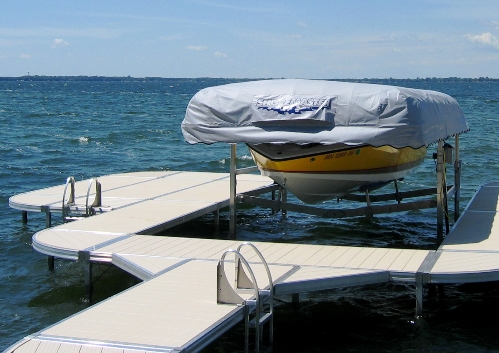
Feb 5, 2019
WHAT SIZE BOAT LIFT DO I NEED?
A boatlift can come in several styles. In this first of a four-part series, we discuss Cantilever, PWC, ShorePorts, and Track systems.
Each boatlift has a specific way it operates, and the conditions under which it should be used. We’ve narrowed the selections down to (8) different types of boat lifts and PWC lifts used most often in N.E. Wisconsin. The more you know about them the more confident your purchasing decision will be.
Cantilever Boatlift
A cantilever lift is generally suitable if you are on a moderate depth inland lake. If the water depth does not fluctuate more than 12” in a boating season, a cantilever lift may work for you.

Cantilever Boatlift by ShoreMaster
Cantilever boatlifts require more water depth than a Vertical lift – (usually 12” of water versus 6″). The lifting rack does not lower into the water as far as other options. Plus, you still have to allow enough water above the lift rack to float your boat on it.
Additionally, they generally have a lifting height of 30” to 40” which is too low for the bay of Green Bay. What if you have waves of 36” or higher or a water surge. Your boat is in danger of getting washed off the rack.
Due to these limitations, a cantilever boat lift is not used on the Door County Peninsula very often. These limitations also mean the resale value is going to be less.
PWC Lift
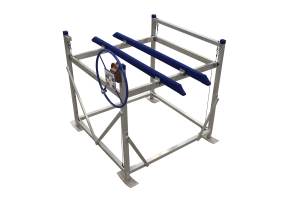
Vertical PWC Lift by ShoreMaster
PWC (Jet Ski lifts) come in 2 styles: Vertical and Floating. (We have excluded the Cantilever lifts.)
ShoreMaster’s vertical PWC lifts allow you to get into shallow water and raises your boat 50″ high. It operates in the same fashion as a standard vertical boat lift. It provides excellent protection for your PWC.
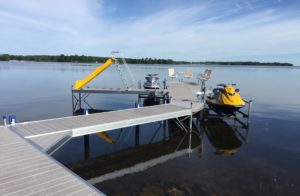
ShoreMaster PWC Lift
ShorePort
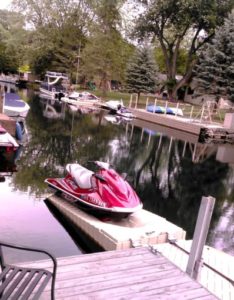
ShorePort PWC Lift by ShoreMaster
ShoreMaster’s Floating lifts (ShorePort) are excellent on rivers that fluctuate in depth, or marinas and inland lakes. They are very simple to use and need very little water to operate. The floating lift requires no maintenance, and you simply drive up onto it. No need to have a motor or crank a wheel.
Wave action above 15” is not recommended for this type of “boatlift.” Combine a floating PolyDock with the PWC floating lift, for the perfect combination on a lake or river.
Track or Ramp System
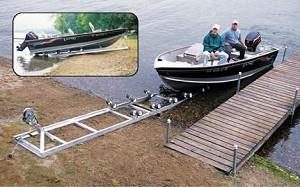
Roll-n-Go Boat Ramp
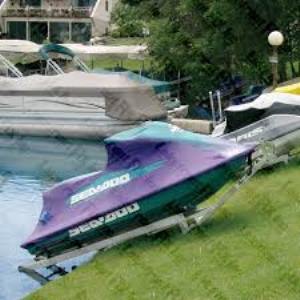
Roll-n-Go PWC Track System
The track or ramp system is still another option. The personal watercraft ramp comes with a 25-foot nylon loop and winch which prevents scratching while loading the PWC. The basic unit measures 11′ long. There are optional 8′ and 30″ extensions to increase the length of your ramp. How about an adjustable 11″ – 14″ width which accommodates even the largest jet skis.
Basic ramps are available with capacities of 750 lb up to 2,000 lb capacity. See Also: http://roll-n-go.com/
The Track system works best when the supports can be anchored into the ground. Without anchoring, the tracks can move by wave action and the result is a twisted frame. These are ideal for inland lakes when only the basic length is needed, as shown above, and the track is secured.
The PWC or boat can be hand operated or a Lift Boss motor option is available.
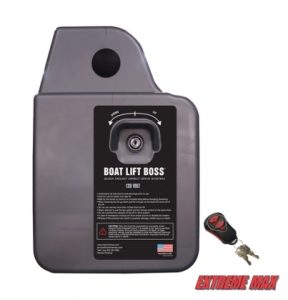
Lift Boss
In part 2 of this series we discuss three more options: Hydraulic boatlifts, Elevator lifts, and Floating lifts.
Publication Dates
Part 1 of 4 – Cantilever, PWC, ShorePorts, Tracks Feb 5, 2019
2 of 4 – Hydraulic, Elevator Lifts, Floating lifts Feb 12, 2019
3 of 4 – Vertical lifts Feb 19, 2019
4 of 4 – Calculations Feb 26. 2019
Do you have a friend that may be interested in this information? Please share a link to this article with them.
PWS is located at 7325 State Hwy 57, that’s 1 mile North of County MM (Hwy 42) and 3 miles South of Sturgeon Bay at the Idlewild Road intersection. Our staff is here year-round to assist you.
Jan 15, 2019
WHAT DOES A DOCK COST?
That’s the question our sales team is asked all the time. We have the answer to this question – “It depends.”
Seriously though, that’s the truth – because it depends on so many factors. Your answer to these simple questions will help us to determine the cost of your pier:
- Where will it be located?
- The type of lake bottom you have?
- The size of the waves you encounter?
But, not to worry, our sales team knows the Door County peninsula. Our sales team lives and work here. We know what to expect and we will guide you through the process. We have customers on virtually every shoreline on the Door County peninsula.
One of the first questions we ask is “where will it be installed?” This question starts the process by narrowing down the frame construction you need.
You may need a floating dock because the bottom is muddy and the area has no waves. Others need a massive, heavy frame to help hold it in place during a storm.
NEED A DOCK AND NEW TO THE AREA?
Have no idea what to expect? Our list of customers is so extensive, we can look up other docks that we sold in your area. Site visits are very important and we offer them FREE.
Door County is a unique area. There are areas where a wave of 5 inches is considered a big wave. Then, there are areas where 5-foot waves are the norm.
A floating dock will not work in areas with large waves. A stationary or wheel-in dock will not work in a deep, muddy situation. Given these examples, it makes sense that one type of dock may not work in both areas. We have to ask questions to narrow our recommendations down.
To determine your cost we have to look at the three main components: Frame, Decking, and size of your structure.
HOW MANY FRAME CHOICES ARE THERE?
Pier & Waterfront Solutions (PWS) offers EIGHT frame styles. That’s more choices than anyone else.
Frame choices include:
Aluminum
TS9 (Stationary or Wheel in)
RS7 (Stationary or wheel in)
RS4 (Stationary with Curved frames optional)
FTS9 (Floating)
Poly
Polydock (Floating)
As a one-stop dealer, you’ll find a solution for all your dock & boat lift needs here.
FRAME EXAMPLES
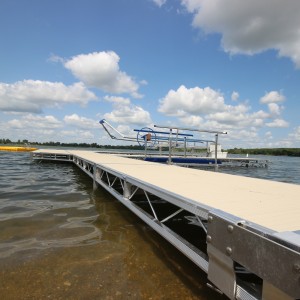
ShoreMaster TS9 Dock

ShoreMaster RS7 and RS4 Curved Dock
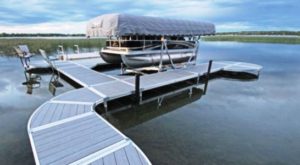
RS4 dock & RS4 Curved dock by ShoreMaster
Polydock by ShoreMaster
Create your perfect waterfront experience with the most user-friendly pier on the Door County peninsula. ShoreMaster aluminum dock systems provide exceptional stability and versatile configuration options.
Infinity TS9 Dock Frame
Available in Standing or Wheel-in Configurations
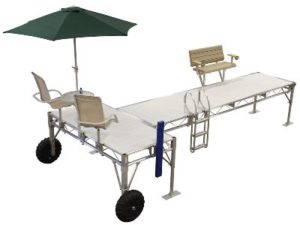
ShoreMaster TS9 Wheel-in Dock
The 9” frame is incredibly sturdy for its weight. It’s great for the rough waters of Green Bay. The truss frame is the most popular dock construction on the bay of Green Bay.
Infinity RS7
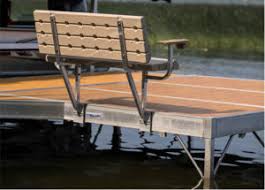
ShoreMaster RS7 Standing Dock
Standing or Wheel-in configurations available
RS7 frames are one of the most stable and attractive pier systems on the market.
The 7” frame can be configured to fit nearly any layout you desire. Perfect for a rocky to soft lake bottoms with shallow to moderate water depths.
Infinity RS4
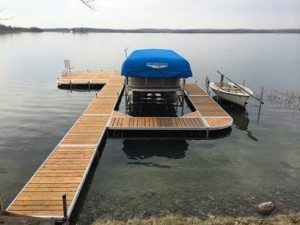
ShoreMaster RS4 dock with Curved Dock Sections
The ShoreMaster Infinity RS4 is highly configurable and durable. RS4 frames are ideally suited for a firm to slightly soft lake bottoms. The 4” frame easily handles shallow to moderate water depths and waves.
Don’t forget – these sections can be combined with the RS4 Curved units for even more configurations.
Floating FTS9
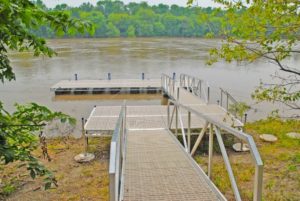
FTS9 Floating Dock
ShoreMasters Floating FTS9 is the perfect choice for, muddy, fluctuating, deep water conditions.
No more having to adjust the pier height during low or high water situations. A stable, floating dock system, it uses premium dock flotation and with a sturdy truss frame. It looks great and requires minimal maintenance
Polydock
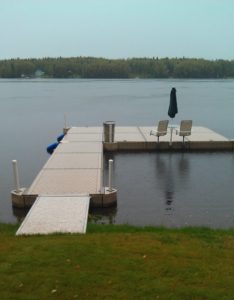
ShoreMaster Polydock
Floating Dock Sections
Polydock products help you get out and enjoy your time on the water. It is a floating, low-maintenance system that is functional as well as attractive. Accessories like the Shore Port personal watercraft lifts (https://www.shoremaster.com/lifts/lift-models/shoreport/) and a complete line of accessories are available.
You’ll be enjoying your new Polydock system in no time at all.
As you can see there are MANY options available for your particular needs. Follow up with Part 2 to see your choices in decking.
Looking for more detailed information on dock frames follow this link: https://wisconsinpws.com/piers-docks/
Publication dates:
Part 1 – What does a Dock cost?
2 – What type of decking is available?
3 – Which dock configuration should I choose?
Need Help Planning a Pier System For Your Home or Cottage?
Do you have a friend that may be interested in this information? Please share a link to this page with them.
PWS is located at 7325 St. Hwy 57. That’s 1 mile North of County MM (Hwy 42) and 3 miles South of Sturgeon Bay at the Idlewild Road intersection.
Our staff is here year-round to assist you.
Aug 28, 2018
ESD: What is it? Part 1 of 2
ESD, also known as Electric Shock Drowning, is a form of drowning caused by an electric current in the water. Where does the electric current originate? It could be your boat, a malfunctioning charger or lighting system. More on this in Part 2 of this series.
I have a fiberglass boat hull – that should protect swimmers – Right??
Yes, but you also have a motor with a metal prop in the water. As a result, this exposes people in the area of the boat to an electrical shock. The shock is greater as they get closer to the source of the problem.
Why is ESD even more dangerous in freshwater?
In freshwater, electrical current passes through the body paralyzing the body muscles. The strongest, most experienced swimmer in the world will not be able to swim through the current field if this happens.
Is there a warning of ESD?
Yes, there is:
- The victim will feel tingling, numbness, pain, and paralysis. That is the first sign of a problem. The closer they get to the source of the current the stronger the sensations will be – and the more paralyzed they will become.
- Initially, the victim will be able to shout, but if they unknowingly try to swim towards the electrical source, this ability will cease as they become paralyzed.
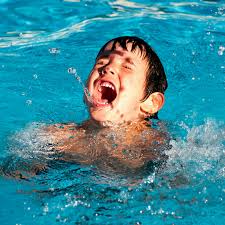
Still able to communicate
- The ability to “shout” more than once is critical. It is the difference between an ESD, an electrocution victim, and a drowning victim. An electrocution victim may not be able to shout at all. A drowning victim can only shout once or twice before his/her lungs fill with water.
- Typically, if the victim of ESD is not close to the source, he can shout and tell you what is happening. A drowning victim cannot yell as their lungs fill with water.
- Many times the ESD victim looks distressed and not as playful as usual. The muscles will no longer function as normal.
- The situation may turn into drowning once the victim begins to get water in their lungs.
How about Electrocution
- A possible victim will be able to scream, usually only once. The victim’s muscles will cease to function almost immediately.
- There will be a sudden cessation of all activity
- The victim usually rolls on their back with their face out of the water and is not responding if wearing flotation.
- If not wearing flotation, they will likely roll onto their face.
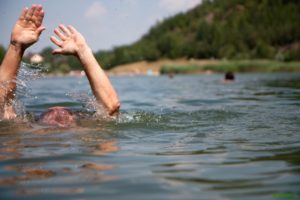
A swimmer in distress
Drowning
- The victim cannot speak or shout
• Reflexive “ladder climbing” with their arms even for an experienced swimmer.
• Looks “playful.”
• Lasts ~60 seconds with an adult and as little as 20 seconds with a child
• Slips below surface
What to do if you suspect an ESD situation
- Keep everyone out of the water – and if they are already in the water – DO NOT allow them to swim back to the dock unless the sensation gets stronger while swimming away from the dock or boat. Remember, the source may be a nearby dock, pump or boat.
- Try to get others in the area to swim away from your dock at least 100 yards and then go to the shore. The electrical current is stronger nearest the source and dissipates as you get away from it.
- Resist the natural impulse to jump into the water to help. You will become a victim yourself. Do NOT jump into the water. Use the Reach, Throw, Row, DON’T GO technique below.
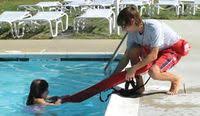
The safest way to help someone in distress
- Protect yourself by using an oar, a float or other non-conducting material to pull the swimmer to safety once the electrical source is shut off See the caption to the right.
- Immediately disconnect all power.
- Take the victim to the hospital to make sure there are no lingering effects that could be dangerous.
In General

Performing CPR if needed
- ESD victims are good candidates for successful Cardiopulmonary Resuscitation (CPR).
- Learn to perform CPR and maintain your training.
- To retrieve a person in the water, reach, throw, and row, but don’t go.
- Make sure your children understand the importance of not swimming anywhere there could be electricity. Don’t let them roughhouse on docks. Tell them what to do if they feel a tingling or shock in the water (see below).
I want to test for current myself. Can I do it?
Yes, with my digital voltmeter, put the negative lead to a ground, drop the positive lead into the water, if the needle moves, even slightly – you may have AC Voltage in the water. Having an electrician do the testing is the best way
- Have your boat tested once a year to see if it is leaking electricity, or buy a clamp meter and test it yourself. If you find any problems, have your boat inspected by a qualified electrician.
- Have a qualified ABYC electrician install an ELCI on your boat (refer them to the ABYC E-11 Standard) or use an ELCI in the shore power cord. As an alternative, install an isolation transformer on the boat.
- Test the GFCI/ELCI at least once a month or per the manufacturer’s specifications.
- DO NOT do your own 120-volt AC electrical work on a boat or hire an electrician who is not familiar with ABYC standards to do it. Many of the problems that lead to electrical faults result from the differences between shore and boat electrical systems and standards.
- NEVER dive from your boat to work on underwater fittings when it is plugged into shore power.
- DO NOT use common household extension cords for providing shore power to your boat. Use, and encourage other boaters to use shore power cords built to UL standards. Make sure the connections DO NOT touch the water.
If You Have A Private Dock
- NEVER swim within 100 yards of ANY dock using electrical power!
- If you have not electrified your dock or put an AC system on your boat, weigh the risks carefully before doing so.
- Need electricity on your dock – hire a licensed electrician and make sure the wiring meets the requirements in NFPA 303 and NEC 555. If your dock is already wired, hire an electrician to check that it was done properly. Docks are exposed to the elements, their electrical systems should be inspected at least once a year.
- If you normally run a power cord from your house or garage to charge your batteries, make sure the outlet has a GFCI and include an ELCI somewhere in the shore power cord. See part 2 of this series.
- NEVER swim off your dock without shutting down all shore power to the boat and the dock.
- Even if you adhere to all of these rules, nearby docks can still present a shock hazard. Educate your neighbors and work together with them to make the waterfront safe.
What if…
Someone you were with fell out of a boat without their life jacket – Would you know what to do?
- REACH: Hold on to the dock or your boat and reach your hand, a boat oar, a fishing pole, or whatever you have nearby, to the person. Many times these people have a fear of drowning and they will pull you under. Do not touch metal yourself.
- THROW: If you can’t reach far enough, toss things that float for the person to grab.
- ROW: If you’re in a boat, use the oars to move the boat closer to the person in the water, or call out to a nearby boat for help. Don’t use the boat’s motor close to a person in the water; they could be injured by the propeller
- DON’T GO: Don’t go into the water You will become a victim yourself. Call out for help. Never use a metal ladder or stairs to enter the water when there is an electrical problem
Be careful reaching from the boat or dock – If you are touching metal, you may be a path to ground yourself.
In part two of this series, we will explain more about the GFCI and ELCI.
Where is PWS?
PWS is located in the center of Door County at 7325 St Hwy 57. It is located 1 mile North of County MM (Hwy 42) and South of Sturgeon Bay. Look for the intersection of Idlewild Road.
Want us to address a dock or boat lift topic for you? Feel free to give us a call.
Call Jerry at 920-493-4404 or Email Jerry@wisconsinpws.com for more information.
Jul 24, 2018
BoatLift Safety Reminders
BoatLift Safety requires constant vigilance. No one can predict when a cable will snap, or when lightning will occur. Children’s safety is paramount whenever they are near a boatlift. This article originally appeared on the Davit Master web site.
This information is important and is well worth reviewing again.
WARNING
BOATLIFTS WITH REMOTE CONTROL SYSTEMS
Turn off the power source on A.C. Powered Units (Electrical Breaker) to the lift when not in use. This prevents any outside sources or accidental transmissions from activating the boat lift/remote control system.
WARNING
ELEVATOR BOATLIFTS WITH TRACKS IN THE WATER
Turn off the power source (Electrical Breaker) to the lift when not in use A.C. Powered units.
WARNING
ALL BOATLIFTS
- BoatLifts are for use by adults only.
- Keep hands and clothing away from all moving parts.
- BoatLifts are not designed for lifting humans.
- Never ride on the boat when lifting or lowering the boat.
- Do not exceed the factory recommended load capacity of the lift.
- Make sure no persons are under, near or on the lift during operation.
- Do not allow the boat to fill with water.
- Do not power your boat onto the lift.
- Always turn the power source off to your lift when servicing your boat or lift.
- Do not swim in the area of the Boat Lift.
- BoatLifts are heavy equipment and should be treated as such
- Inspect your cables once a month.
- Lubricate your cables monthly with penetrating oil.
- Replace cables that are frayed or rusted.
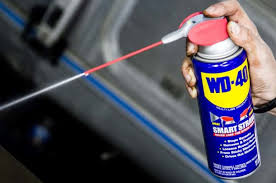
Boat Lift Cable Lubricant
Just a reminder:
For those who consider the current heat wave as unbearable – this is what the outdoors looked like a mere 70 days ago –
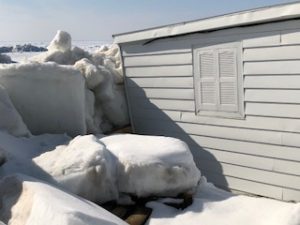
2018 Arrowhead Beach – Crushing a boathouse
Where is PWS?
PWS is located in the center of Door County at 7325 St Hwy 57. It is located 1 mile North of County MM (Hwy 42) and South of Sturgeon Bay. Look for the intersection of Idlewild Road.
Want us to address a dock or boat lift topic for you? Feel free to give us a call.
Call Jerry at 920-493-4404 or Email Jerry@wisconsinpws.com for more information.
